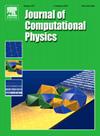Latent neural PDE solver: A reduced-order modeling framework for partial differential equations
IF 3.8
2区 物理与天体物理
Q2 COMPUTER SCIENCE, INTERDISCIPLINARY APPLICATIONS
引用次数: 0
Abstract
Neural networks have shown promising potential in accelerating the numerical simulation of systems governed by partial differential equations (PDEs). Different from many existing neural network surrogates operating on high-dimensional discretized fields, we propose to learn the dynamics of the system in the latent space with much coarser discretizations. In our proposed framework - Latent Neural PDE Solver (LNS), a non-linear autoencoder is first trained to project the full-order representation of the system onto the mesh-reduced space, then a temporal model is trained to predict the future state in this mesh-reduced space. This reduction process simplifies the training of the temporal model by greatly reducing the computational cost accompanying a fine discretization and enables more efficient backprop-through-time training. We study the capability of the proposed framework and several other popular neural PDE solvers on various types of systems including single-phase and multi-phase flows along with varying system parameters. We showcase that it has competitive accuracy and efficiency compared to the neural PDE solver that operates on full-order space.
求助全文
约1分钟内获得全文
求助全文
来源期刊

Journal of Computational Physics
物理-计算机:跨学科应用
CiteScore
7.60
自引率
14.60%
发文量
763
审稿时长
5.8 months
期刊介绍:
Journal of Computational Physics thoroughly treats the computational aspects of physical problems, presenting techniques for the numerical solution of mathematical equations arising in all areas of physics. The journal seeks to emphasize methods that cross disciplinary boundaries.
The Journal of Computational Physics also publishes short notes of 4 pages or less (including figures, tables, and references but excluding title pages). Letters to the Editor commenting on articles already published in this Journal will also be considered. Neither notes nor letters should have an abstract.
 求助内容:
求助内容: 应助结果提醒方式:
应助结果提醒方式:


